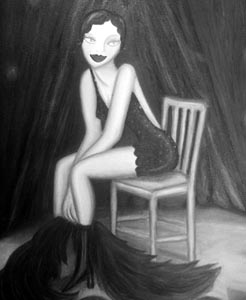
Marcus Hanschen
Artist Teresa Moore's sexually charged paintings are more at home in nightclubs than in museums
By Simone Stein
Local artist Teresa Moore is a rarity in the academicized art world--a self-supporting painter with no time for theory. A native Arizonian who has lived in LA, London and Rome, she creates smoldering paintings of flappers, showgirls and sophisticates that ache with tarnished glamour and slightly sinister decadence. Moore's palette is heavy with rich burgundies and almost sickly yellows, and her paintings have hard-luck titles like "Here Comes a Regular," "To Hell With Love" and "The Mean Reds" (Holly Golightly's label for depression).
After stints as an actress and a groupie, Moore taught herself to paint 12 years ago. Her lack of formal training likely accounts for her democratic sensibility and her disinterest in abstract and conceptual art. She paints with her fingers, using a brush only to add details like eyelashes. Following in the noble tradition of Henri Toulouse-Lautrec and, later, Keith Haring, Moore's sexually charged paintings are based on bold, accessible graphic design that's more at home in nightclubs than in museums.
Metropolitan: Your style reminds me of those old French liquor advertisements. How did your aesthetic develop?
Moore: When I first started painting this stuff I was really influenced by comics--I was working for a comic book company. I'm self-taught. It's been an ongoing development for me. When I first started out it was really abstract, stream-of-consciousness sort of stuff, and as I went along it started getting more and more figurative. I sort of came full circle to when I was a kid drawing dancers, showgirls and things like that. I used to be an actress, so I'm really inspired by performers.
Metropolitan: You say in your press release that "cabaret girls, jazz-age lounge lizards and circus performers recall a risqué lost generation that in this age can only exist within the confines of a fertile imagination." Do you really think that kind of seedy sophistication is gone for good?
Moore: We can't really live that way, so we have to be voyeurs about it. I mean, you can't smoke in bars! There was a real free sexuality then which we're not able to have so easily. Plus, they looked cool. It was all about drinking and dancing and color. But I do think there was an underlying sort of despair.
Metropolitan: Your work focuses exclusively on women. Do you consider your paintings feminist?
Moore: Yeah, because these women are so independent. People have gotten on me about how there's no men or the men look like vampires and stuff, but it's just that I see women as being stronger than men. There's an independence about those women and a loneliness about them. And I love to paint them! I don't get anything out of painting men.
Metropolitan: How much have nightclubs been a part of your life?
Moore: A lot. I used be a groupie.
Metropolitan: To who?
Moore: Lots of people (laughs). Most people think of a groupie as someone who does a lot of drugs and drinks a lot, but I was very straight. There was a totally voyeuristic element to it--I was in it, but at the same time I sort of stood outside it. A lot of my inspiration when I started painting came from clubs. I had a lot of friends in bands and I'd go sit in the back of the club and just draw.
Metropolitan: How have you managed to make a living outside the gallery scene?
Moore: I am pretty much representing myself now. I've been through the gallery thing. Unfortunately, a lot of galleries don't stay open for very long, aside from the real highbrow ones, and my art isn't highbrow art--a lot of artists have looked down on the stuff I do.
I'm always on the lookout for atmospheres, the feeling of a place or the design of a place. I showed at a club in New York, and that was really cool because not only did my work go with the atmosphere, but everybody who was there was partying and so they really related to it. Now that I know my audience, I'm trying to steer toward those atmospheres rather than galleries where only certain people are going to see it.
My work doesn't really appeal to the upper crust. It appeals to regular people, so I'm just trying to expose it to people that are going to like it. I've seen how people relate to it--they'll come up and say, "Oh my god, that's me!" The characters in the paintings are not anybody in particular, but there's something about them that people will pick up on that touches them.
[ San Francisco | MetroActive Central | Archives ]
![[MetroActive Arts]](/arts/gifs/art468.gif)